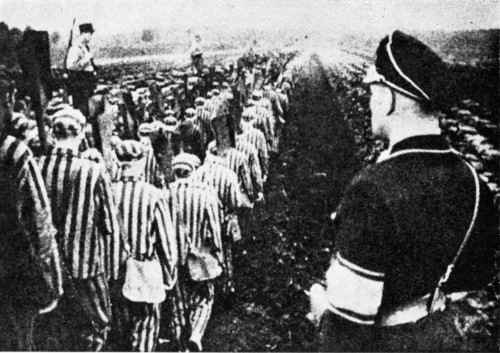 |
|
|
[Page 349]
by Avraham Schudroff
Translated by Allen Flusberg
|
|
| Jewish prisoners being led to work by the Nazis |
|
|
| During the Yizkor Meeting and candle-lighting ceremony for the Kamenetz martyrs on Mt. Zion in Jerusalem |
Footnote
by Professor Shmuel Eisenstadt
Translated by Allen Flusberg
It was no accident that I took upon myself the redaction of the Kamenetz-Litowsk Memorial Book, for I have been transported back to the world of my origins and of my early youth by this history of the Kamenetz Jewish community and of its tragic destruction—after many long years of life struggles and accomplishments.
On a summer day of 1893, I came to Kamenetz accompanied by my beloved mother, may she rest in peace. We had come there from the estate of my grandfather, Rebbe[2] Yakov Ber—the estate was located in Chemeri, near Kamenetz[3]. A child of only seven, I strolled through the quiet streets of Kamenetz, gazing at first upon the amiable faces of the ordinary Jewish people, and looking at the Slup [Medieval fortress-tower], about which we had been told so many children's stories.
A little later I began to understand what kind of intellectual sources my dear father, may he rest in peace, had been nourished on. Although he had spent his childhood years in Chemeri, where he had grown up, he was actually a scion of scholarly laymen and community leaders of Brisk.
While raising me my father had told me much about Kamenetz, about its lay scholars and intellectuals, and how this town had been influenced intellectually by nearby Brisk. And later, when I was deeply immersed in the study of our people's history, I developed a strong bond with my kindred brothers and sisters of Kamenetz and the surrounding area.
It became clear to me that the profound national spirit and the studious and worldly activism of the small Kamenetz community had been derived mainly from the fact that this shtetl, like other Jewish settlements in the country, lay on the great historical route of our people, as they moved from west to east—from Spain, France and Germany towards Poland and Lithuania.
[Page 354]
During the long and difficult Jewish struggle for survival, Jewish culture deepened and solidified here. Here also the institutions of national Jewish autonomy—the Council of the Four Lands[4]—at one time took hold.
The destruction of Kamenetz-Litowsk is a most tragic and bitter chapter within the greater history of the Jewish destruction. It is a story of the downfall and eradication of a modest but daring nucleus of Jewish culture and sociability, which might otherwise have developed further, spawning welcome and desirable intellectual forces within our people. Every page, every single line of this Kamenetz-Litowsk Memorial Book, cries out bitterly—each in its own way—over this loss.
May our people know and remember what it has lost as a result of the blood-soaked hands of the Nazi murderers!
May the children, grandchildren and great-grandchildren of the Kamenetz Jews, wherever they may be, know and remember their origins with pride and sorrow, and may they continue to carry on their ancestors' banner!
May the bloody foe—the enemy of our people and of humanity—not be forgotten, nor forgiven for the blood they shed—the blood of the elderly, women and children—including the blood of the Kamenetz Jewish community annihilated by them!
Footnotes
|
|
JewishGen, Inc. makes no representations regarding the accuracy of
the translation. The reader may wish to refer to the original material
for verification.
JewishGen is not responsible for inaccuracies or omissions in the original work and cannot rewrite or edit the text to correct inaccuracies and/or omissions.
Our mission is to produce a translation of the original work and we cannot verify the accuracy of statements or alter facts cited.
 Kamenets, Belarus
Kamenets, Belarus
 Yizkor Book Project
Yizkor Book Project
 JewishGen Home Page
JewishGen Home Page
Copyright © 1999-2026 by JewishGen, Inc.
Updated 3 May 2021 by LA